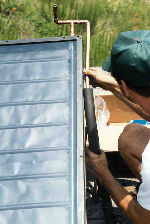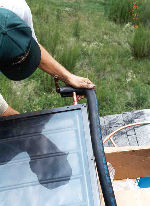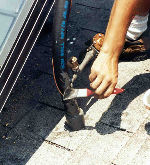
![]()
In order to prevent heat loss from the piping, pipe insulation is always installed on both external and internal system piping. This is usually the last step in the installation process. Just before instructing the homeowner on system operation and maintenance.
 |
After having pressurized the system to make sure that there were no leaks at any of the joints or valves, the installer then installs insulation on the system piping. A rubber type insulation is preferred over plastic insulation. The external thickness of the insulation depends on local climatic conditions. |
 |
The installer makes sure that all fittings are also covered by the insulation. Since heat is energy, insulation is installed at all exposed piping locations in order to prevent heat and therefore, energy loss. |
 |
Even unused collector piping ends are also insulated to prevent unnecessary heat loss. |
 |
Rubber insulation will eventually deteriorate when left outdoors. To prevent this, a coat of latex or other similar protective coating is applied to the insulation. It is a good idea to also protect sensor wiring. |
 |
In this case, the installer has chosen to use a paint that matches the roof color. A little aesthetics goes a long way in pleasing the customer. |
